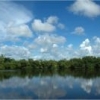re Pt welaka, Bruce's "affects the rules regarding collection" means "you can't collect (or harass) those in Florida." They are not common. Pt signipinnis is common in the right habitat, but you have to be at least as far west as the Apalachicola River, an hour or more west of Tallahassee.
But Pt metallicus is local to the Ocala area. Mostly found in clear running water. An excellent location for those is Alexander Springs Creek, at the CR-445 bridge, approx 10 miles south of Astor Park (SR-40.) From your list, that site also has Lucania goodei, and, in the shallow areas near the shore, pygmy sunfish. And pygmy madtoms, bluespotted sunfish, etc.
A little further north, you have the Ocala National Forest. Some of the "prairies" there have very nice Fundulus lineolatus when they're wet, especially Hopkins Prairie. Which also have F. chrysotus and sometimes if you are lucky, F rubrifrons.
LOTS of water in the Ocala area, a good mixture of ponds, prairies, creeks, rivers, and even springs. You can't get access to all the likely spots of course, but there's lots of options. The national forest land is nice, because other than the major spring heads, you can collect pretty much anywhere you find water. (With your fishing license, of course.) You did say you wanted "to observe" ... swimming/snorkeling at most of the springheads is permitted, there may be a small daily use/entrance fee.
I'd recommend:
* Fishes in the Fresh Waters of Florida - An Identification Guide and Atlas - Robins et al, 2018
* DeLorme Florida Atlas & Gazetteer.
This time of year, be especially careful about heat buildup in any buckets or containers you put any "keepers" into. Take lots of water, and monitor your temperatures too.
If you go as far east as Lake George, be careful, that area is known for having big gators.
HTH









